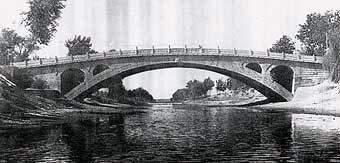THE
SEGMENTAL ARCHED BRIDGE - 7th CENTURY
A
conceptual breakthrough occurred when a Chinese engineer was
the first to realize that an arch did not have to be a semi-circle.
A bridge could be built which was based not on the traditional
semi-circle arch but on what is known as a segmental arch. The
way to envisage this is to imagine a gigantic circle embedded
in the ground, of which only the tip shows above ground level.
This tip is a segment of a circle, and the arch it forms is
a segmental arch. Such an arch forms the central arch of the
bridge.

The
Great Stone Bridge spanning the River Chiao Shui is the world’s
first segmental arch bridge, built in stone by the architect
Li Ch’un in the 610 and renovated in the twentieth century.
The bridge has a span of 123 feet. Not only was the great segmental
arch in the center an innovation (semi-circular arches had existed
before), but the semi-circular arch spandrels to either side
were also new. They let through additional floodwaters and also
allowed the structure to be lighter in weight. Such arches did
not reach Europe for five hundred years.
From
The Genius of China by Robert Temple
Ancient
Technology Index
|